The Burghers of Calais: A Symbolic Monument of Sacrifice and Courage
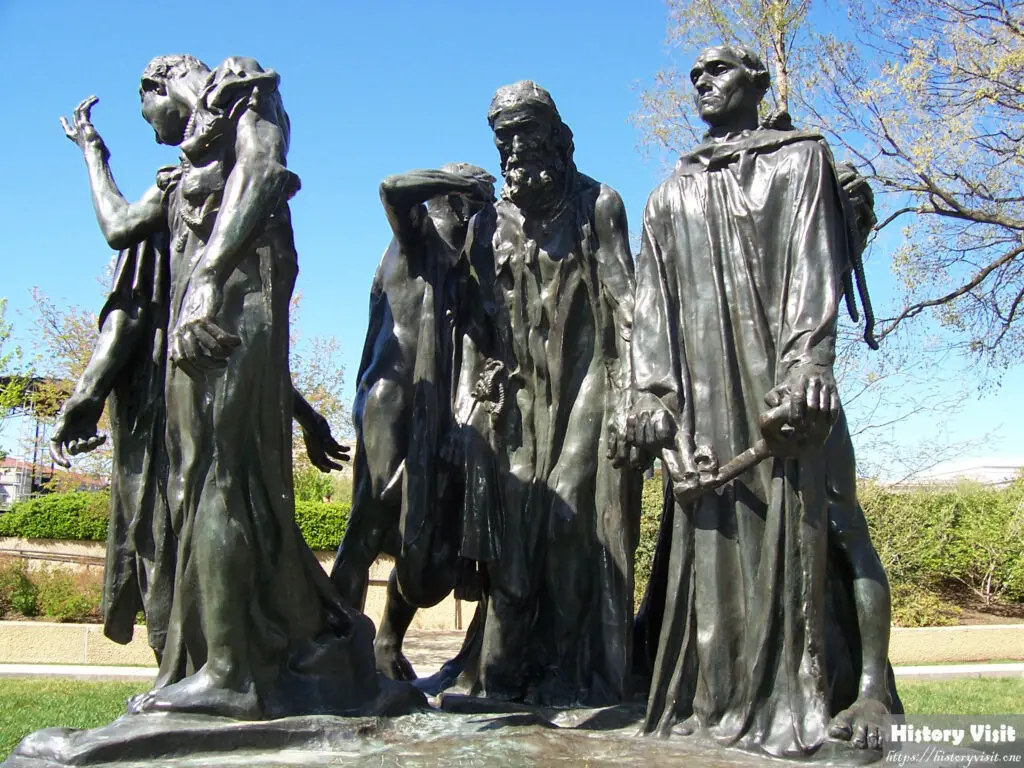
Introduction:
Auguste Rodin’s “The Burghers of Calais” stands as a testament to the enduring power of art to capture the essence of human emotion and historical significance. Created between 1884 and 1889, this monumental sculpture portrays the six burghers of the French town of Calais, who offered themselves as hostages to King Edward III of England during the Hundred Years’ War. One of the casts of this masterpiece resides in the Musée Rodin in Paris, France, serving as a poignant reminder of sacrifice and courage.
As one of Rodin’s most celebrated works, “The Burghers of Calais” encapsulates the collective spirit of defiance and selflessness in the face of adversity. Through his masterful craftsmanship and profound understanding of human anatomy, Rodin immortalized the harrowing moment when these brave men volunteered to save their city from destruction. Each figure in the sculpture exudes a distinct sense of resolve, capturing the complexity of their emotions as they prepare to meet their fate.
Beyond its artistic merit, “The Burghers of Calais” embodies universal themes of heroism and resilience that continue to resonate with audiences today. By delving into the historical context, artistic interpretation, and lasting legacy of this iconic sculpture, we can gain a deeper appreciation for its significance in both art history and the human experience.
Historical Context:
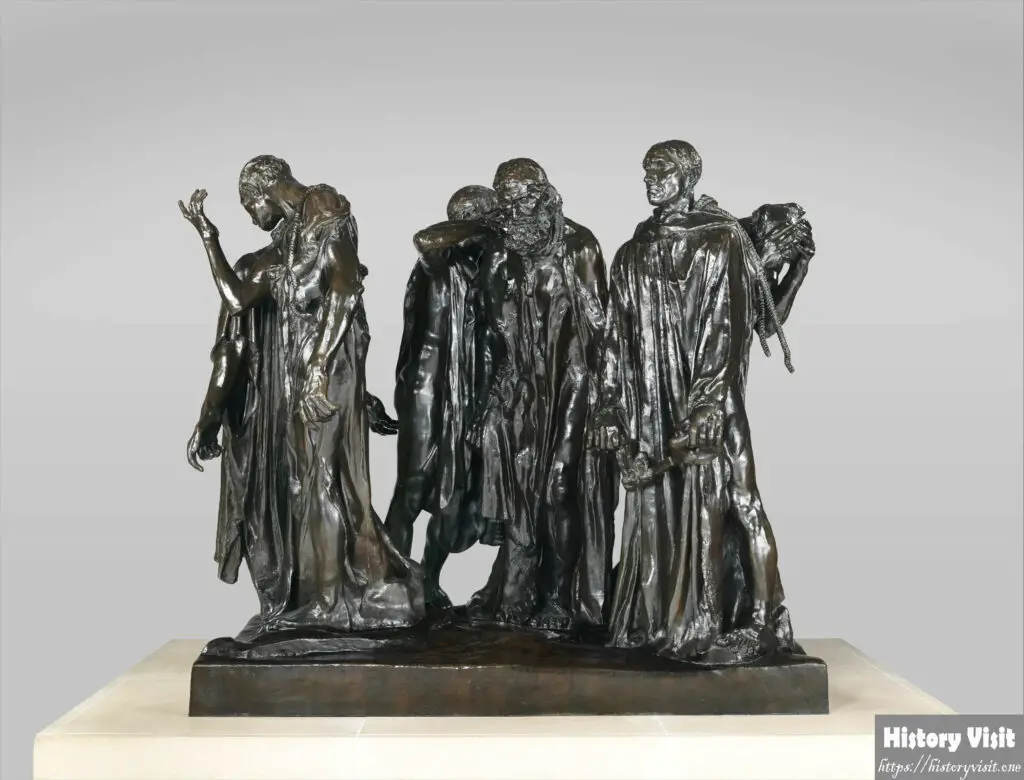
The genesis of “The Burghers of Calais” lies in the turbulent events of the Hundred Years’ War, a protracted conflict between England and France that lasted from 1337 to 1453. In 1346, King Edward III of England laid siege to the port town of Calais, seeking to establish a strategic foothold in France. After a year of blockade and starvation, the citizens of Calais faced imminent surrender unless they could appease the English king’s demands.
In a remarkable act of self-sacrifice, six prominent citizens of Calais, known as burghers, volunteered to surrender themselves to King Edward III to spare their fellow townspeople from further suffering. Led by their mayor, Eustache de Saint-Pierre, these men offered their lives in exchange for the salvation of Calais. Their noble gesture touched the heart of the English queen, Philippa of Hainault, who interceded on their behalf, ultimately sparing their lives.
Rodin’s Interpretation:

Auguste Rodin approached the subject of “The Burghers of Calais” with a profound reverence for the historical significance of their sacrifice. Rejecting conventional notions of heroism, Rodin sought to capture the raw humanity of these men as they confronted the inevitability of their fate. Unlike traditional monuments that glorify military conquests, Rodin’s sculpture emphasizes the emotional turmoil and existential angst experienced by the burghers.
Through his meticulous attention to detail and innovative sculptural techniques, Rodin imbued each figure with a sense of individuality and depth of character. From the hunched posture of Eustache de Saint-Pierre to the anguished expression of Jean d’Aire, every element of the sculpture conveys a distinct narrative of courage and vulnerability. Rodin’s use of fragmented forms and dynamic poses further enhances the psychological intensity of the scene, inviting viewers to empathize with the burghers’ plight.
Rodin’s interpretation of “The Burghers of Calais” transcends mere historical documentation, offering a timeless meditation on the human condition. By capturing the essence of sacrifice and resilience, Rodin invites us to reflect on our own capacity for courage and selflessness in the face of adversity. As we contemplate the enduring legacy of this masterpiece, we are reminded of the profound impact that art can have in shaping our understanding of the past and inspiring us to forge a better future.
Composition and Techniques
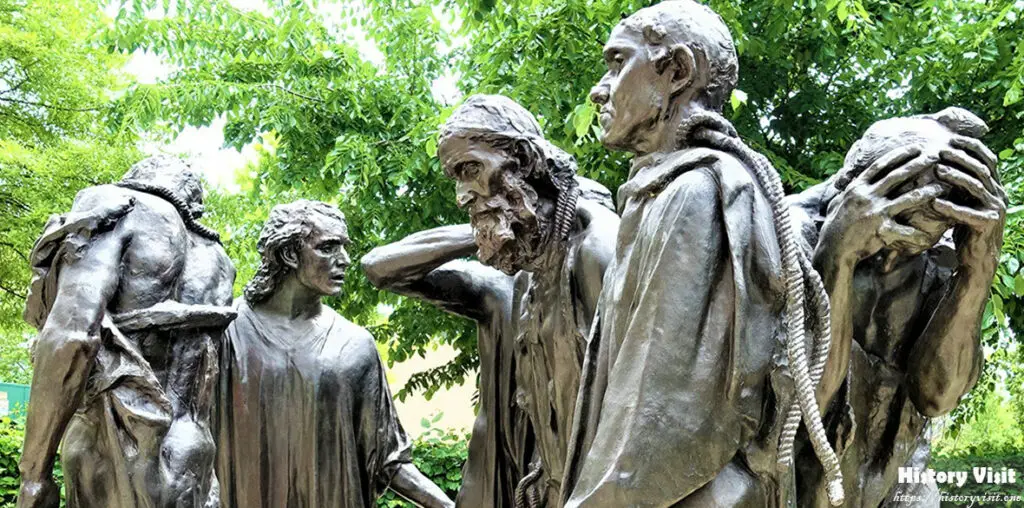
Composition:
“The Burghers of Calais” is a monumental sculpture composed of six life-size figures arranged in a semi-circle, each positioned at different heights and distances from a central focal point. The figures are depicted in various states of emotional turmoil, their bodies contorted and their faces expressing a range of emotions, from anguish to resignation. At the center of the composition stands Eustache de Saint-Pierre, the leader of the burghers, his figure slightly elevated and turned towards the viewer, commanding attention and conveying a sense of resolve.
Rodin’s composition is dynamic and asymmetrical, with each figure occupying its own distinct space within the semi-circle. The arrangement of the burghers creates a sense of movement and tension, as if they are on the brink of action or contemplation. The placement of the figures also encourages viewers to move around the sculpture, exploring it from different angles and perspectives, thereby engaging with the emotional depth of each character.
Techniques:
Rodin employed a variety of innovative sculptural techniques to bring “The Burghers of Calais” to life. One of his most notable techniques was his use of partial figures and fragmented forms to convey a sense of psychological depth and emotional intensity. Rather than portraying the burghers as idealized heroes, Rodin depicted them with a rawness and vulnerability that resonates with viewers on a visceral level. He sculpted their bodies with a meticulous attention to detail, capturing the nuances of musculature and texture to evoke a sense of physical and emotional weight.
In addition to his mastery of form, Rodin was also a pioneer in the use of texture and surface treatment to enhance the expressiveness of his sculptures. In “The Burghers of Calais,” he employed a variety of techniques, such as rough-hewn surfaces and deep gouges, to create a sense of ruggedness and intensity. By juxtaposing areas of smoothness with areas of roughness, Rodin achieved a dynamic interplay of light and shadow that further heightened the dramatic impact of the sculpture.
Rodin’s innovative use of composition and techniques in “The Burghers of Calais” not only revolutionized the art of sculpture but also deepened our understanding of the human condition. Through his masterful craftsmanship and profound insight into the human psyche, Rodin created a timeless masterpiece that continues to inspire and provoke contemplation to this day.
Themes and Interpretations
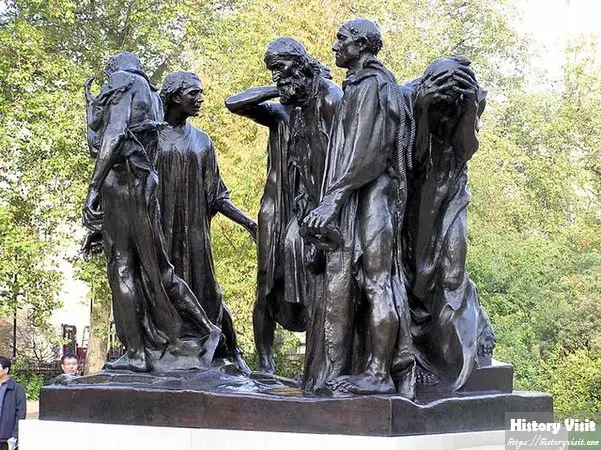
Themes:
“The Burghers of Calais” explores a multitude of themes that resonate deeply with viewers, transcending the historical context of the Hundred Years’ War to touch upon universal aspects of the human experience.
Sacrifice: At the heart of the sculpture lies the theme of sacrifice, embodied by the six burghers who offered themselves as hostages to save their city from destruction. Their willingness to endure personal hardship for the greater good speaks to the inherent nobility of the human spirit and serves as a poignant reminder of the power of selflessness.
Heroism: Rodin’s depiction of the burghers challenges conventional notions of heroism, presenting them not as triumphant warriors but as ordinary individuals thrust into extraordinary circumstances. Through their expressions of anguish and resignation, Rodin invites viewers to reconsider what it means to be a hero and to recognize the quiet courage displayed by those who confront adversity with dignity and grace.
Resilience: Despite their dire predicament, the burghers of Calais stand resolute in the face of adversity, their bodies contorted but their spirits unbroken. Their defiant stance reflects the resilience of the human spirit and serves as a testament to the enduring capacity of individuals to endure hardship and persevere in the pursuit of justice and freedom.
Interpretations:
“The Burghers of Calais” invites a myriad of interpretations, with each viewer likely to glean their own insights and emotions from Rodin’s powerful sculpture.
Symbol of Defiance: The anguished expressions and tense postures of the burghers convey a palpable sense of defiance in the face of overwhelming odds. By choosing to surrender themselves to the enemy rather than capitulate to tyranny, the burghers assert their agency and assert their right to determine their own fate, inspiring viewers to stand up against oppression and injustice in their own lives.
Reflection on Mortality: Rodin’s portrayal of the burghers as mortal beings, vulnerable to pain and suffering, serves as a poignant reminder of the fleeting nature of life. Their grim determination to face death with dignity forces viewers to confront their own mortality and consider the legacy they wish to leave behind.
Call to Empathy: Through their expressive faces and haunting poses, the burghers of Calais elicit a profound sense of empathy from viewers, inviting them to imagine themselves in the shoes of these brave men. By encouraging empathy and understanding, Rodin’s sculpture fosters a deeper connection between past and present, reminding us of the timeless relevance of the burghers’ sacrifice and the enduring power of compassion to unite humanity across time and space.
In essence, “The Burghers of Calais” transcends its historical origins to offer a timeless meditation on the complexities of the human condition, inviting viewers to reflect on the themes of sacrifice, heroism, and resilience in their own lives.
Reception and Legacy
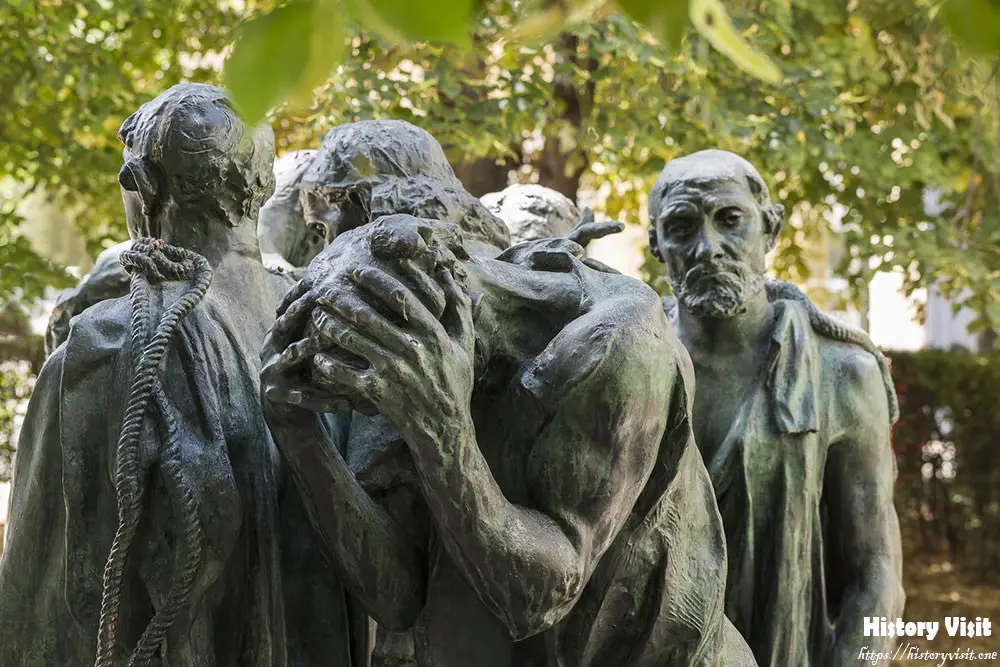
Reception:
Upon its completion in 1889, “The Burghers of Calais” elicited a range of reactions from both critics and the public. Some praised Rodin’s innovative approach to sculpture, hailing the work as a masterpiece that captured the raw emotion and human drama of its subject matter. Critics lauded Rodin’s departure from conventional notions of heroism, applauding his ability to imbue the burghers with a sense of vulnerability and authenticity that resonated deeply with viewers.
However, others were less enthusiastic, criticizing Rodin’s departure from traditional sculptural techniques and his unconventional portrayal of the burghers. Some found fault with the fragmented forms and rough textures of the sculpture, arguing that they detracted from its overall aesthetic appeal. Despite these criticisms, “The Burghers of Calais” ultimately found favor with audiences, who were moved by its powerful depiction of sacrifice and courage.
Legacy:
Over the years, “The Burghers of Calais” has emerged as one of Rodin’s most celebrated and enduring works, securing its place as a seminal masterpiece in the history of sculpture. Its legacy extends far beyond the confines of the art world, inspiring countless artists, writers, and thinkers to explore themes of sacrifice, heroism, and resilience in their own work.
The sculpture’s profound impact can be seen in its numerous reproductions and adaptations, which have proliferated in museums, public spaces, and private collections around the world. Each cast of “The Burghers of Calais” serves as a potent reminder of the burghers’ noble sacrifice and the timeless relevance of their story in the modern era.
Moreover, “The Burghers of Calais” continues to spark scholarly debate and critical inquiry, with art historians and critics exploring its significance in relation to Rodin’s broader body of work and its place within the broader context of 19th-century sculpture. Through exhibitions, publications, and academic research, scholars seek to deepen our understanding of Rodin’s artistic vision and the enduring legacy of “The Burghers of Calais” as a symbol of human courage and resilience.
In conclusion, “The Burghers of Calais” stands as a testament to the enduring power of art to capture the essence of the human spirit and to provoke thought and emotion in viewers across generations. Its reception and legacy underscore its status as a masterpiece of monumental sculpture and a timeless meditation on the themes of sacrifice, heroism, and resilience.
Conclusion:
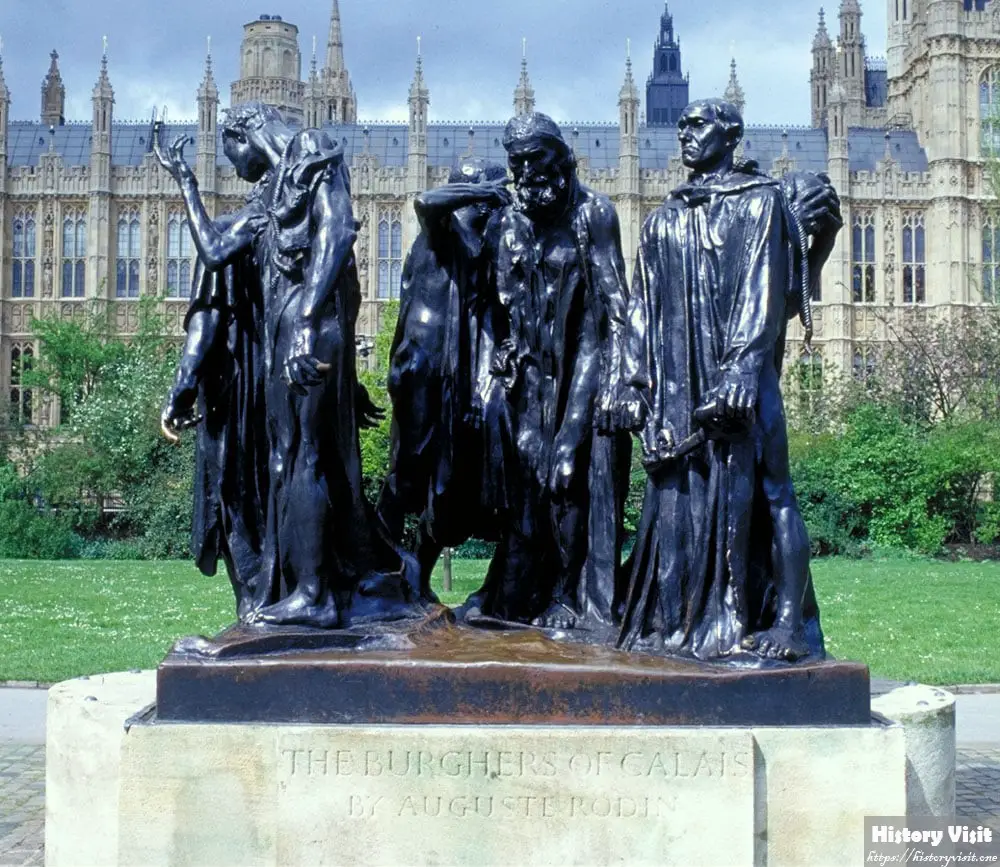
“The Burghers of Calais” stands as a towering achievement in the annals of art history, serving as a poignant reminder of the enduring power of human courage and sacrifice. Through his masterful craftsmanship and profound insight into the human psyche, Auguste Rodin immortalized the noble spirit of these six brave men who defied tyranny and embraced their fate with dignity.
As we gaze upon the solemn figures of “The Burghers of Calais,” we are transported back to a pivotal moment in history when ordinary individuals rose to extraordinary heights in the name of freedom and justice. Their selfless act of heroism continues to inspire generations, reminding us of the profound impact that individuals can have in shaping the course of history.
In an age marked by uncertainty and turmoil, “The Burghers of Calais” serves as a beacon of hope and resilience, urging us to confront adversity with fortitude and compassion. As we reflect on the enduring legacy of this timeless masterpiece, we are reminded of the transformative power of art to illuminate the darkest corners of the human experience and ignite the flame of collective memory.


